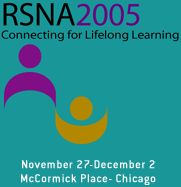
Abstract Archives of the RSNA, 2005
LPR03-04
Influence of Oxygen-inhalation on Pulmonary Hemodynamics during Different Breath-holding Technique: Quantitative Assessment by Velocity-encoding MR Imaging with SENSE Technique
Scientific Posters
Presented on December 1, 2005
Presented as part of LPR03: Chest (MR Perfusion, Technique)
Munenobu Nogami MD, Presenter: Nothing to Disclose
Yoshiharu Ohno MD, PhD, Abstract Co-Author: Nothing to Disclose
Takanori Higashino MD, Abstract Co-Author: Nothing to Disclose
Daisuke Takenaka MD, Abstract Co-Author: Nothing to Disclose
Masahiko Fujii MD, Abstract Co-Author: Nothing to Disclose
Kazuro Sugimura MD, PhD, Abstract Co-Author: Nothing to Disclose
To determine the influence of oxygen-inhalation on pulmonary hemodynamics during different breath-holding technique by using quantitatively assessed velocity-encoding MR imaging with SENSE technique (velocity MRI).
10 healthy male volunteers (mean age, 29.9 years old) underwent velocity MRI with breath-holding by shallow inspiration and shallow expiration. For assessment of the influence of oxygen-inhalation on pulmonary hemodynamics during breath-holding, velocity-MRIs with and without administration of oxygen were continuously acquired by 2D-Fourier method (TR 5.4 ms/ TE 3.0 ms, a constant 15° flip angle, VENC 150cm/sec) with SENSE at a 1.5 T scanner. Each scan was performed with 20 time frames with ECG-gating during the first 75% of the cardiac cycle and continuously repeated without preparation interval during single breath-holding. Heart rate and oxygen saturation of the subjects were also monitored. From time-velocity curve of each velocity MRI data, stroke volume, maximal flow velocity, the ratio of retrograde to the antegrade flow volumes (the regurgitation fraction), and maximal change in flow rate during ejection were calculated. Difference of each calculated parameter between first and last scans in each breath-holding with oxygen-inhalation was statistically compared with that without oxygen-inhalation by using paired t-test.
Difference of stroke volume on velocity MRI with oxygen-inhalation was significantly smaller than that without oxygen-inhalation by expiratory (p=0.03) and inspiratory (p=0.04) breath-holdings. On each breath-holding method, difference of maximum flow velocity and regurgitation fraction had no significance between with and without oxygen-inhalation. On inspiratory breath-holding, difference of maximal change in flow rate with oxygen-inhalation was significantly larger than that without oxygen-inhalation (p=0.0006).
Oxygen-inhalation modulates quantitatively assessed pulmonary hemodynamics during different breath-holding technique. In addition, stroke volume during inspiratory and expiratory breath-holding and maximal change in flow rate during inspiratory breath-holding were significantly affected by oxygen-inhalation.
To determine the influence of oxygen-inhalation on pulmonary hemodynamics during different breath-holding technique by using quantitatively assessed velocity-encoding MR imaging with SENSE technique (velocity MRI).
10 healthy male volunteers (mean age, 29.9 years old) underwent velocity MRI with breath-holding by shallow inspiration and shallow expiration. For assessment of the influence of oxygen-inhalation on pulmonary hemodynamics during breath-holding, velocity-MRIs with and without administration of oxygen were continuously acquired by 2D-Fourier method (TR 5.4 ms/ TE 3.0 ms, a constant 15° flip angle, VENC 150cm/sec) with SENSE at a 1.5 T scanner. Each scan was performed with 20 time frames with ECG-gating during the first 75% of the cardiac cycle and continuously repeated without preparation interval during single breath-holding. Heart rate and oxygen saturation of the subjects were also monitored. From time-velocity curve of each velocity MRI data, stroke volume, maximal flow velocity, the ratio of retrograde to the antegrade flow volumes (the regurgitation fraction), and maximal change in flow rate during ejection were calculated. Difference of each calculated parameter between first and last scans in each breath-holding with oxygen-inhalation was statistically compared with that without oxygen-inhalation by using paired t-test.
Difference of stroke volume on velocity MRI with oxygen-inhalation was significantly smaller than that without oxygen-inhalation by expiratory (p=0.03) and inspiratory (p=0.04) breath-holdings. On each breath-holding method, difference of maximum flow velocity and regurgitation fraction had no significance between with and without oxygen-inhalation. On inspiratory breath-holding, difference of maximal change in flow rate with oxygen-inhalation was significantly larger than that without oxygen-inhalation (p=0.0006).
Oxygen-inhalation modulates quantitatively assessed pulmonary hemodynamics during different breath-holding technique. In addition, stroke volume during inspiratory and expiratory breath-holding and maximal change in flow rate during inspiratory breath-holding were significantly affected by oxygen-inhalation.
Nogami, M,
Ohno, Y,
Higashino, T,
Takenaka, D,
Fujii, M,
Sugimura, K,
Influence of Oxygen-inhalation on Pulmonary Hemodynamics during Different Breath-holding Technique: Quantitative Assessment by Velocity-encoding MR Imaging with SENSE Technique. Radiological Society of North America 2005 Scientific Assembly and Annual Meeting, November 27 - December 2, 2005 ,Chicago IL.
http://archive.rsna.org/2005/4419603.html

